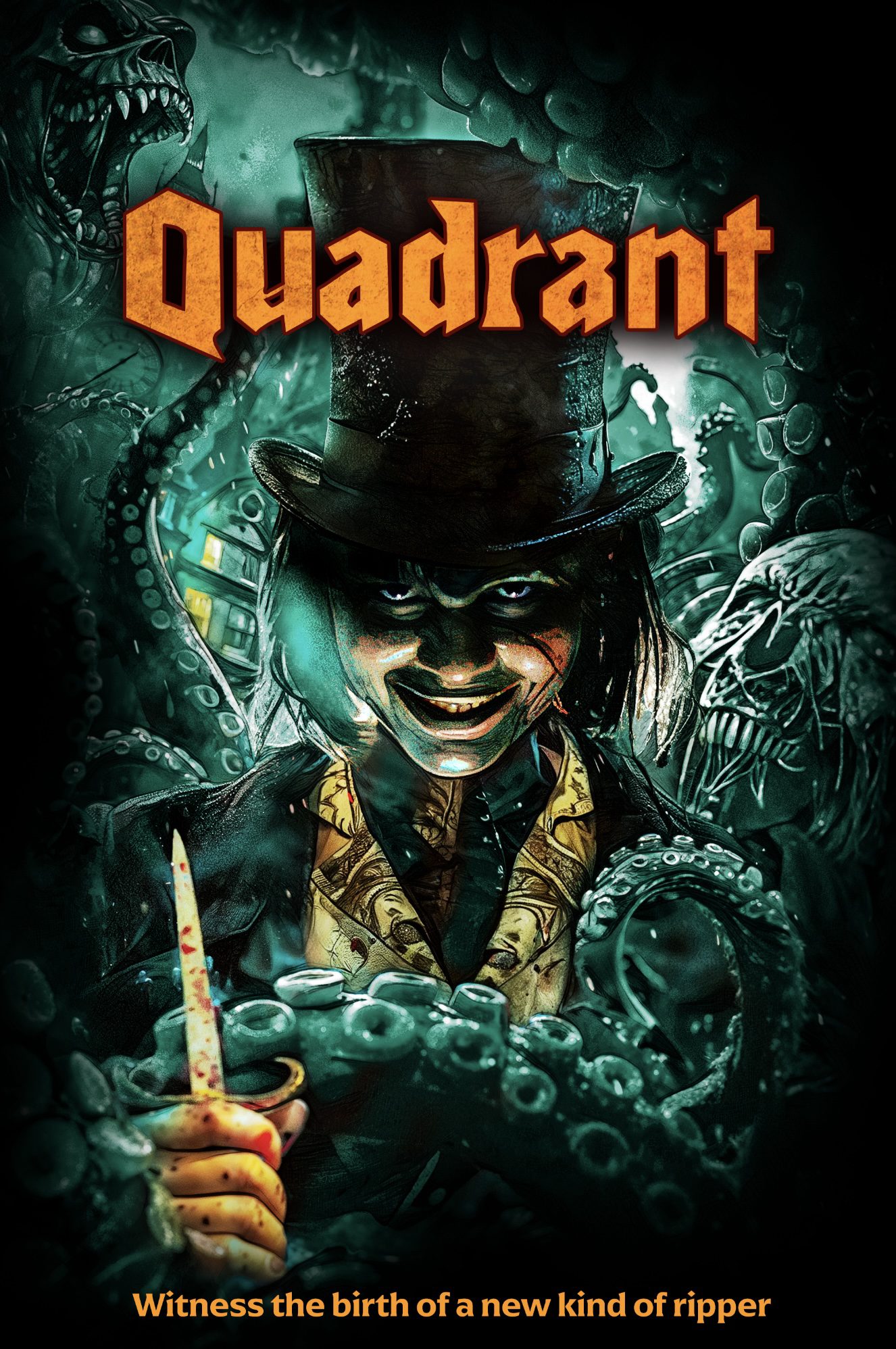What happens when the shackles surrounding a person’s inner demons are loosened? The new film Quadrant explores that idea, delving into the potential for dormant murderous tendencies to emerge when given the right catalyst.
In the realm of independent horror, few names carry as much weight as Charles Band and his prolific Full Moon Features studio. Their latest installment, Quadrant, marks the 400th film release from Full Moon Features and the inaugural offering from their new Pulp Noir label, which focuses on edgier, weirder, darker horror and dark fantasy films.
Directed by Charles Band, the godfather of B-movies with a career spanning over four decades. As the founder of Full Moon Features, Band has been responsible for cult classics like the “Puppet Master” series, “Trancers,” and “Subspecies.”, this steampunk-infused sci-fi slasher blends virtual reality with the bloody legacy of history’s most infamous serial killer – Jack the Ripper, creating a unique entry in the exploration of humanity’s darkest obsessions when nothing is left to keep them in check.
Known for his ability to create memorable franchises on shoestring budgets, Band’s films often blend horror with elements of fantasy, science fiction, and dark humor.
As Full Moon’s milestone production, Quadrant serves as both a celebration of Band’s prolific career and a glimpse into the studio’s potential future direction.
The film follows the story of scientists Harry and Meg, who have developed Quadrant, a VR helmet that forces users to experience their worst fears. By confronting these nightmares head-on in an artificial world, the wearers are promised liberation from psychological torment. However, when a young woman named Erin, consumed by an unhealthy fixation on Jack the Ripper’s grisly legacy, dons the helmet, she begins to unlock the bloodthirsty darkness hidden deep within.
What initially begins as Erin indulging her morbid curiosities in a simulated 19th-century London soon bleeds into terrifying reality. Suddenly, this unhinged “New Ripper” brings her virtual killing spree into the present day, viciously slashing her way through the city streets. The only way to stop her rampage is for an even deadlier killer to enter Quadrant’s synthetic realm and battle Erin on her own depraved terms.


At a brisk 76 minutes, Quadrant moves at a characteristic Charles Band pace. The rapid-fire scene changes and little setup between scenes are hallmarks of Band’s style. This approach spends no time on exposition; instead, it abruptly transitions from scene to scene, with the majority of the film’s run time consisting of Erin and Robert, the only other patient of Quadrant, attending sessions.
Outside of these sessions, the film follows Erin’s obsessive fixation on Jack the Ripper’s murderous legacy. In the artificial reality constructed by Quadrant’s software, Erin can live out her darkest fantasies, as a remorseless, blade-wielding killer stalking the alleys of a computer-rendered Victorian London. However, the film posits that once that door is opened, once someone’s repressed urges are allowed to run rampant even in a virtual realm, it becomes increasingly difficult to separate fantasy from reality.
In that sense, the film holds up a mirror to our cultural obsession with serial killers, peeling back the romanticized layers to reveal the rotten core beneath. Erin’s path from feverishly consuming the Ripper’s gruesome legacy to literally becoming the embodiment of that depravity is a slippery slope.


While Quadrant touches on further plot narratives, such as Erin’s ability to suddenly control Quadrant, allowing her to manipulate the machine even when not wearing the helmet, these aspects are never fully explored due to the film’s brisk runtime and it’s dedication to allotting it’s time to therapy sessions and showcasing only Erin’s murderous tendencies, while leaving these other aspects to her character on the cutting room floor.
There are also fleeting hints at richer character story arcs, like the suggestion that Meg herself has used Quadrant to control her own dark urges in the past, presenting an intriguing counterpoint to Erin’s descent into violence. However, these potentially compelling subplots are only lightly scratched at the surface, leaving the viewer to wonder what sort of deeper story could have been told if the film had a longer runtime.
And while Shannon Helene Barnes brings a feral intensity to Erin, as she progresses from an obsessed fan to a full-blown copycat killer, the supporting cast, including Emma Reinagel and Christian Carrigan, is underdeveloped.
So much more could have been explored with Carrigan’s portrayal of Robert, a character plagued with fear, who eventually finds himself under the sway of Erin, as her unwitting accomplice in her growing fixation on becoming the next Jack the Ripper.


While Quadrant may not break new ground in terms of plot or character development, in the end, Quadrant stands as a testament to Band’s enduring vision and Full Moon Features’ commitment to pushing the boundaries of low-budget horror. This is pure, unadulterated horror insanity, custom-built for those who like their scares served up with a side of schlock and a hefty dose of splatter.
“Quadrant” sits at an interesting intersection within the horror genre, blending elements from various subgenres and calling to mind several notable predecessors. Its virtual reality premise evokes comparisons to films like “eXistenZ” (1999) and “The Lawnmower Man” (1992), which similarly explore the dangers of losing oneself in artificial worlds.


Meanwhile, the concept of confronting one’s fears in a simulated environment bears similarities to psychological horror films like “Flatliners” (1990) and “The Cell” (2000). In the context of modern horror, “Quadrant” appears to be tapping into the recent trend of tech-horror seen in films like “Cam” (2018) and “Host” (2020), while its steampunk aesthetic sets it apart visually.
Within Charles Band’s oeuvre, “Quadrant” seems to be pushing for a grittier, more psychologically intense experience compared to some of his campier, more creature-feature oriented works. This positioning potentially places “Quadrant” as a bridge between traditional low-budget horror and more contemporary, theme-driven genre pieces.
As the 400th release from the studio and the first under the Pulp Noir label, it sets an intriguing tone for what’s to come. It may not be for everyone, but for those who revel in the grimy underbelly of genre cinema, Quadrant offers a thrilling, if somewhat uneven, journey into the heart of darkness.


And for die-hard fans of Band’s, Quadrant is a welcome addition to his blood-soaked legacy. It’s a reminder of why he’s remained a pivotal figure in independent horror for decades.
So, strap on that VR helmet and prepare for a journey into the depths of depravity. Just remember – in Band’s world, the line between fantasy and reality is as thin as the edge of a Ripper’s blade, and once crossed, there’s no going back. Welcome to the Quadrant, where your darkest fantasies become horrifyingly real.
“Quadrant,” the latest mind-bending offering from Full Moon Features and Charles Band, is set to unleash its virtual terror on August 23, 2024. This milestone 400th release from the studio and inaugural film under their new Pulp Noir label promises to deliver a unique blend of steampunk aesthetics, virtual reality thrills, and Jack the Ripper-inspired mayhem.


























































![Mason Ramsey – Twang [Official Music Video] Mason Ramsey – Twang [Official Music Video]](https://i.ytimg.com/vi/xwe8F_AhLY0/maxresdefault.jpg)
























